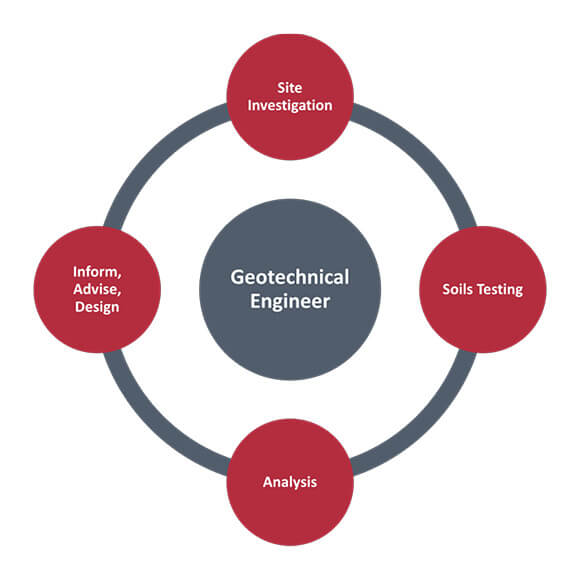9 Simple Techniques For Geotheta
9 Simple Techniques For Geotheta
Blog Article
Some Ideas on Geotheta You Need To Know
Table of ContentsThe Best Guide To GeothetaThe Basic Principles Of Geotheta The smart Trick of Geotheta That Nobody is DiscussingFacts About Geotheta UncoveredThe smart Trick of Geotheta That Nobody is Discussing

They perform site examinations, accumulate samples, execute laboratory tests, and evaluate data to examine the viability of the ground for construction projects - Geo Tech Engineer. Based upon their searchings for, geotechnical designers provide recommendations for structure design, slope security, preserving frameworks, and mitigation of geotechnical dangers. They work together with various other specialists, such as architects, structural designers, and construction teams, to make sure that geotechnical factors to consider are incorporated right into the total task design and implementation
By examining the behavior and properties of dirt and rock, they can recognize prospective geotechnical dangers such as landslides, soil settlement, or incline instability. Their expertise assists prevent failings or accidents that could threaten lives and home. Here are some detailed responsibilities and responsibilities of a geotechnical designer: Website Investigation: Geotechnical engineers conduct site examinations to collect data on subsurface conditions.
They interpret the data to comprehend the properties and behavior of the soil and rock, including their strength, leaks in the structure, compaction characteristics, and groundwater conditions. Geotechnical Evaluation and Design: Geotechnical designers evaluate the data gathered during website investigations to evaluate the security and viability of the website for building and construction tasks. They execute geotechnical estimations and modeling to review factors such as birthing capability, settlement, slope security, lateral planet stress, and groundwater circulation.
Little Known Facts About Geotheta.
Structure Design: Geotechnical engineers play a vital role in making foundations that can securely support the intended structure. They analyze the dirt conditions and load needs to establish the proper foundation kind, such as shallow structures (e.g., footings), deep foundations (e.g (https://www.metal-archives.com/users/geotheta)., piles), or specialized techniques like soil renovation. They take into consideration elements such as negotiation limits, bearing capability, and soil-structure interaction to create optimum structure styles
They evaluate building strategies, screen site tasks, and carry out field inspections to verify that the layout referrals are adhered to. If unanticipated geotechnical concerns emerge, they examine the situation and give suggestions for remediation or modifications to the design. Threat Analysis and Mitigation: Geotechnical designers analyze geotechnical dangers and risks connected with the job site, such as landslides, liquefaction, or soil disintegration.

Cooperation and Interaction: Geotechnical designers work very closely with various other professionals included in a project, such as architects, architectural engineers, and building groups. Efficient interaction and collaboration are important to integrate geotechnical considerations right into the total job style and building procedure. Geotechnical engineers provide technical knowledge, answer inquiries, and make sure that geotechnical demands are satisfied.
A Biased View of Geotheta
Right here are some sorts of geotechnical engineers: Structure Designer: Structure engineers specialize in creating and evaluating foundations for frameworks. They analyze the soil problems, lots needs, and site attributes to establish one of the most suitable foundation type and design, such as shallow foundations, deep structures, or specialized methods like stack foundations.
They review the factors affecting slope stability, such as soil buildings, groundwater problems, and incline geometry, and establish methods to avoid slope failures and reduce dangers. Quake Designer: Earthquake engineers specialize in assessing and making frameworks to withstand seismic forces. They analyze the seismic threat of a website, examine soil liquefaction potential, and create seismic layout requirements to make sure the security and resilience of frameworks throughout earthquakes.
They execute area testing, collect samples, and analyze the accumulated information to characterize the dirt residential or commercial properties, geologic formations, and groundwater problems at a website. Geotechnical Instrumentation Engineer: Geotechnical instrumentation designers focus on surveillance and gauging the habits of dirt, rock, and structures. They mount and keep instrumentation systems that keep track of elements such as soil negotiation, groundwater degrees, slope movements, and architectural displacements to analyze performance and provide very early warnings of possible concerns.
Geotheta - An Overview
They perform tests such as triaxial tests, loan consolidation examinations, direct shear tests, and permeability tests to collect information for geotechnical evaluation and layout. Geosynthetics Engineer: Geosynthetics designers concentrate on the style and application of geosynthetic materials, such as geotextiles, geogrids, and geomembranes. They make use of these products to boost dirt stability, reinforce inclines, supply drainage services, and control erosion.
They often tend to be investigative individuals, which means they're intellectual, introspective, and curious. They are interested, methodical, rational, logical, and rational. Some of them are also social, meaning they're kind, generous, cooperative, person, caring, handy, compassionate, skillful, and pleasant - Consulting Engineers.
In the workplace environment, geotechnical designers make use of specialized software application tools to perform computations, create layouts, and evaluate data. They prepare records, evaluation project specs, communicate with customers and team members, and coordinate job tasks. The workplace setting gives a helpful atmosphere for research study, analysis, and partnership with various other specialists article involved in the task.
The 8-Second Trick For Geotheta
They frequently go to job websites to conduct site examinations, evaluate geotechnical problems, and collect information for evaluation. These check outs entail taking a trip to different places, occasionally in remote or tough terrains. Geotechnical designers may carry out dirt tasting, conduct examinations, and screen building tasks to make certain that the geotechnical aspects of the project are being implemented correctly.
Geotechnical engineers likewise operate in specialized geotechnical laboratories. In these centers, they carry out experiments, do tests on soil and rock examples, and analyze the design residential properties of the products. Geotechnical lab designers work extensively in these atmospheres, handling screening tools, operating tools, and tape-recording information. They collaborate with various other research laboratory team to make certain accurate and trustworthy screening results.
Report this page